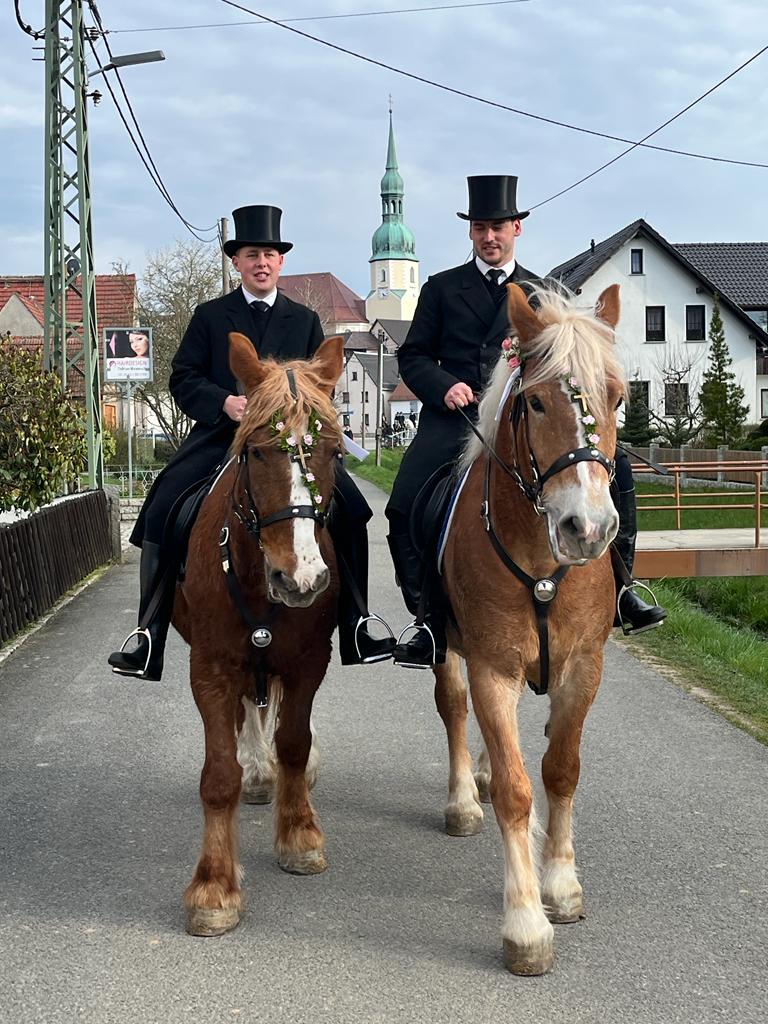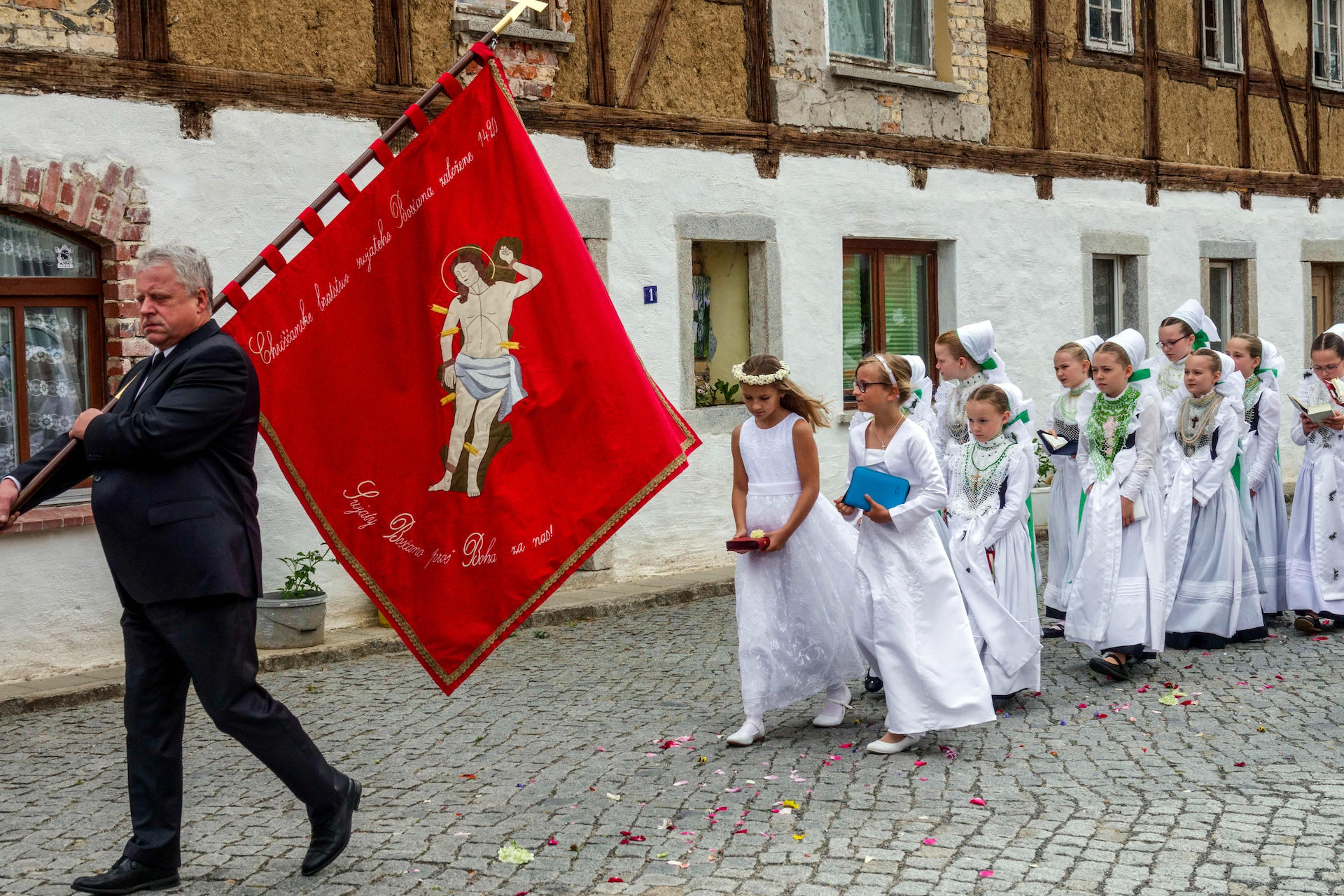Taking the train from Berlin through lush, green forest to the city of Bautzen, passengers pass a number of bilingual signs written in both German and a Slavic language. But even experienced travelers might be confused, because despite some similarities, the signs are not written in Czech or Polish. They’re in Sorbian, a Slavic minority language spoken in the region of Bautzen — Budyšin in the local parlance.
Dobry dźeń means “good day,” a common greeting in Upper Sorbian. The greeting is similar to those of other Slavic languages, including Slovenian and Polish, but Sorbian — serbska in its own language or Sorbisch in German — is very much its own language and culture.
This Slavic minority language has been under threat for several years as the aging community shrinks. Its members and local officials are working hard to recruit Sorbian language teachers and preserve the culture for future generations.
A recognized minority
Concentrated in two of Germany’s 16 states, Saxon and Brandenburg, about 60,000 Sorbs speak one of its two dialects, both very different from German. Upper Sorbian, spoken mainly in Saxony, is more similar to Czech or Slovakian, while Lower Sorbian, found mostly in Brandenburg, is closer to Polish.
Both states are home to a number of public Sorbian-language schools, though officials say they are struggling to fill vacancies.
Saxony’s Ministry of Education has been trying for at least 10 years to recruit new teachers for Sorbian schools, spokesperson Dirk Reelfs says. Last year, there were only 298 Sorbian teachers in the state, spread across 16 primary and secondary schools.
The state of Brandenburg had 79 Sorbian teachers in 2022, down from 81 in 2019, according to the Brandenburg Ministry of Education, Youth and Sports. In a bid to boost applications, the state offers an additional monthly allowance of €600 ($658) for teachers who agree to teach in Sorbian settlements for a certain number of years.
The shortage is so serious that schools have needed to recruit from outside the Sorb community and accept teachers who are still learning the language. To be hired, they only need to understand Sorbian at an intermediate level.
The lack of Sorbian teachers mirrors a wider education crisis in Germany. Throughout the country, 12,000 school teacher positions remain vacant, the state ministries of education warned in January.
That means that for speakers of this endangered language, teaching is a relatively stable job in high demand.

The path to teaching serbska
For teacher Damian Dürlich — or Dyrlich in Sorbian — becoming a Sorbian teacher was a natural choice.
Despite living in Germany, he only spoke Sorbian at home, and only learned German from a childhood friend who couldn’t speak Sorbian. It was a mutually beneficial language tandem, and now Dürlich speaks German at a native level.
Dürlich decided to teach because he wanted to stay in the region where he grew up. He attended the secondary school where he now teaches Sorbian and social studies, then studied Sorbian at the University of Leipzig — the only university in the world that offers a degree in Sorbian Studies.
He enjoys teaching in Saxony, where the classes are smaller than they would be if he taught in a big city. At his school, 60% of the lessons are taught in Sorbian. In the upper classes, Sorbian is spoken during the lessons, but pupils take notes in German.
Sorbian teachers earn the same salary as their German-speaking counterparts. In both cases, there are considerable benefits to becoming a civil servant, particularly when it comes to job security, social security contributions and pensions. With lower monthly contributions, the take-home pay for a civil servant, or Beamte, is higher than for an employee in industry.
“My net earnings after the first year are around €3,000 ($3,300) per month after the health insurance contributions,” Dürlich says. “You can theoretically earn €4,000 ($4,406), when you reach the last level of the salary band, which is really good in Germany, especially in the east of Germany, where the prices are a little bit lower than in West Germany. You can live very, very well.”
Sorbian teachers also earn money translating textbooks and other teaching materials from German, English or French. Even in Saxony, most TV and radio programs are in German, but teachers sometimes write articles for Sorbian newspapers and magazines.
Dürlich says that for his last contribution, he earned around €130 ($134) for six pages. “You will not get rich, but it is OK,” he says. Besides, the biggest benefits are not material — it’s a contribution to the culture.

The Sorbian culture
Sorbian culture is so imperiled that most Sorbs are happy when someone understands even a little bit of the language, Dürlich says.
The group is frequently associated with its traditional clothing, including long, ornately embroidered skirts, and bonnets featuring oversized bows or headdresses.
Regina Matka, who works in Bautzen’s Serbski dom, a cultural and political administrative building, says Sorbs can identify which communities the women belong to based on the patterns and length of their skirts.
For many Sorbian men, Easter is an important occasion, as they take part in the Crostwitz procession, riding from village to village on horseback to announce the resurrection of Jesus Christ on Easter Sunday. Dressed in frocks, black riding gear and top hats, their horses are decorated with flowers, ribbons and embroidered crosses.
Only a very few elderly women wear the traditional clothing in everyday life, and men have almost completely stopped wearing traditional clothing altogether aside from weddings or Easter. But younger people seem eager to revive the customs, at least on special occasions, Dürlich says.
“I’ve noticed that now at special occasions including graduations, or during Sorbian religious celebrations or at weddings, the traditional costumes are worn much more by young women and brides, for example, than when I was a child,” Dürlich says.
For him, “the Sorbian culture is carried by the Sorbian language. The tradition is strongly influenced by the church, for me at least. In Sorbian culture, you know in each part of the year what comes next, what you need to do.”
Like many Slavic cultures, on Good Friday, eggs are dutifully hand painted, etched and decorated, often for hours, before being given as gifts to other family members on Easter Sunday. The ornate eggs are also given on other occasions, including baptisms and weddings, and communities hold competitions for the most beautifully painted eggs.
Traditional clothing is often passed down through generations, along with treasured butter forms, which have become increasingly hard to find, thanks to mass production. According to Sorbian culture, before the wedding dinner, butter is pressed into intricate animal shapes, including lambs and chickens, before being served to the marrying couple.
Many Sorbs also participate in sports clubs and choirs, including Dürlich. “Singing is also strongly celebrated and always present at celebrations, including with a choir,” Dürlich says.
The choir is a good way for non-Sorbian speaking community members to deepen their ties with their heritage, he adds.

A history of persecution
Throughout history, the Sorbian community has endured persecution.
After losing their political autonomy in the 10th century, the Sorbs’ territory diminished, and the population became victims of a systematic effort to suppress their language and heritage. Some communities left Germany in the 1800s and emigrated to Australia and the U.S. During the Weimar and Nazi eras, the Sorbian language was suppressed, and publications banned.
As a result, some Sorbs relate more to the Czech population than the rest of Germany, Dürlich says. Today, the Sorbs are one of Germany’s four recognized minorities, along with the Danish minority, the Frisian ethnic group and German Sinti and Roma people.
Today, a political organization called Domowina represents the concerns of the Sorbian community, while the Serbski Institute, established in the 1950s, advances research on Sorbian language, history and culture.
The Domowina has been appealing since 2008 for financial assistance and cultural safeguarding as Sorbian risks disappearing. In November 2022, Domowina Chairman Dawid Statnik said the organization aimed to increase the number of Sorbian speakers from 60,000 to 100,000 by the year 2100.
Teachers like Dürlich are a fundamental part of that effort. For him, teaching isn’t only about preserving the Sorbian language, but also passing down other cherished Sorbian traditions to younger generations so the culture continues.
Read more
Sign up to keep up to date with ReThink Q.







